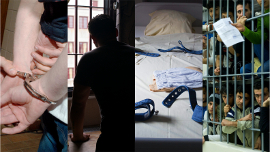The visit provided an opportunity to assess the extent to which the recommendations made after previous CPT visits have been implemented. Particular attention was paid to the treatment of persons in police custody, and prison conditions (with a focus on prison health-care and prisoners classified as "dangerous”).
The majority of the persons met by the delegation who were, or had recently been, detained by the police, indicated that they had been correctly treated. Nevertheless, the CPT’s delegation did receive a significant number of allegations of physical ill-treatment of persons taken into police custody (including from detained juveniles), both at the time of apprehension and during subsequent questioning (in some cases, with a view to extracting a confession or another statement). The CPT called upon the Polish authorities to pursue rigorously their efforts to combat ill-treatment by police officers. Further, the CPT made recommendations aimed at strengthening the fundamental safeguards against police ill-treatment.
The conditions at the police establishments visited were generally adequate, and in some cases even good, for the period of custody provided by law (i.e. a maximum of 72 hours). Similarly, the material conditions of detention were found to be generally satisfactory in the four police establishments for children (PID) visited. Activities offered to juveniles could also be considered adequate for short stays.
In relation to the prisons visited, the delegation did not receive any allegations, nor gather any evidence of recent physical ill-treatment by staff at Lublin, Szczecin, Warsaw-Grochów or Warsaw-Mokotów Remand Prisons and at the three prison hospitals visited. However, at Bydgoszcz Remand Prison, the delegation received some isolated allegations of physical ill-treatment by custodial staff. Further, a few allegations of verbal abuse of foreign inmates were heard at Warsaw-Mokotów Remand Prison.
Inter-prisoner violence did not appear to be a problem at Bydgoszcz, Lublin, Warsaw-Grochów and Warsaw-Mokotów Remand Prisons. That said, at Szczecin Remand Prison, the delegation heard of some incidents of such violence.
Despite the various measures being taken by the Polish authorities, overcrowding remained a problem in all the prisons visited. The CPT called upon the Polish authorities to redouble their efforts to combat prison overcrowding by adopting policies designed to limit or modulate the number of persons sent to prison.
The CPT also called upon the Polish authorities to revise as soon as possible the current norms fixed by legislation for living space per prisoner (i.e. 3 m²) so that, in all penitentiary establishments, there is at least 4 m² per inmate in multi-occupancy cells and at least 6 m² in single cells.
The situation as regards the provision of organised activities to inmates in the establishments visited was still generally very unsatisfactory, in particular for remand prisoners. The CPT again stressed that the aim should be to ensure that every prisoner is able to spend a reasonable part of the day (eight hours or more) outside his/her cell, engaged in purposeful activities of a varied nature (work, education, vocational training, sport, etc.).
As regards the so-called “dangerous” (“N” status) prisoners, the CPT welcomed the continued reduction in the number of such prisoners in the recent years. Further, the quarterly reviews of the “N” status had become much more meaningful since the 2009 visit. Having said that, the Committee remains of the view that the Polish authorities should refine the procedure for allocating a prisoner to "N" status, and for reviewing this allocation, with a view to ensuring that only those inmates who pose an on-going high risk if accommodated in the mainstream of the prison population are accorded "N" status. The CPT was also concerned to note the absence of any changes to the regime applied to “N” status prisoners, which remained very restrictive. The Committee called upon the Polish authorities to fundamentally review that regime and to develop individual plans aimed at providing appropriate mental and physical stimulation to such prisoners.
Turning to prison health-care services, the CPT found the level of health-care staff on the whole adequate at Bydgoszcz, Szczecin and Warsaw-Mokotów Remand Prisons; however, this was certainly not the case at Lublin Remand Prison. It is noteworthy that complaints about delays in gaining access to health care were heard in all the prisons. In addition, in Bydgoszcz, both at the Remand Prison and at the Prison Hospital, as well as at Warsaw-Grochów Remand Prison, the delegation received complaints from prisoners about the quality of the health care provided. The Committee asked the Polish authorities to take necessary remedial action.
The CPT also visited the Warsaw sobering-up centre, which made a positive impression on the delegation.
In their response, the Polish authorities refer to training programmes and other steps taken to address the phenomenon police ill-treatment. Further, information is provided on the measures being taken to combat prison overcrowding, including by placing emphasis on non-custodial measures for remand prisoners and developing alternatives to imprisonment. Reference is also made to measures taken or envisaged to renovate and expand the Polish prisons. The Polish Government also informs the CPT of the efforts to increase the offer of activities for prisoners, to improve the standard of prison health-care and to address the CPT’s recommendations concerning the “N” status prisoners.
The visit report and government response are available on the Committee’s website: http://www.cpt.coe.int
2014 News
The Council of Europe’s Committee for the Prevention of Torture and Inhuman or Degrading Treatment or Punishment (CPT) has published today the report on its most recent visit to Poland, which took place from 5 to 17 June 2013, together with the response of the Polish authorities.
25/06/2014
- Diminuer la taille du texte
- Augmenter la taille du texte
- Imprimer la page

Preventing torture in Europe
www.cpt.coe.int


